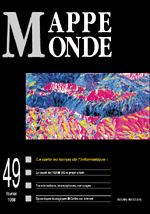

Editorial. Jean-Paul Cheylan, Anne Ruas
Jacques POULAIN. The National Geographic Institute, Yesterday and Today (1 fig.)
The IGN (National Geographic Institute) was created in 1940 and has become a part of Frances's cartographic history.If its role up to now was mainly to create an accurate and up to date map of national territory, it will henceforth also supply numerical data in response to the different needs of its users. Using the numerical system thoroughly changed the IGN's technics and works : it was necessary so as to enter into the information society.
Sylvie LAMY. The Numerical Challenge (1 fig.)
The accessibility to geographic data in numerical form should allow for the rapid creation of products adapted to the specific needs of everyone. However, today's geographic information systems (GIS) offer but few tools which are sufficiently versatile. The research laboratory Cogit, located at the IGN (National Geographic Institute) is working towards the development of methods and tools adapted to complex tasks such as generalisation, positioning of toponyms and the management of data updating.
Colette CAUVIN. Cartographic Transformations (3 fig.)
By differentiating between those transformations which are linked to changes in the state of a map and those which introduce alterations in the bearings of an area, this article reveals one of computer technology's contributions to the field of cartography, cartographic alterations.
Jean-Charles DENAIN, Patrice LANGLOIS. Anamorphosis Mapping (2 fig.)
After presenting anamorphosis mapping as a spatial metaphore, we examine, using some examples, the relevance as well as the semiological and graphic limits of this kind of cartography.
Patrice LANGLOIS, Gilles LAJOIE. Grid Maps and Spatial Precision (2 fig.)
Using grid mapping, we examine the desagregation of areas variables, by reverting to the hypothesis of spatial equirepartition of population. The goal is to approximate the differenciated rules of variables desagregation by combining different informations, the nature of which is either morphological, topological or environmental.
Joël BOULIER. A New Forest Formation Mapping Method (2 fig.)
To those who are limited by scale constraints linked to forest data collection, we present an original method of ponctual data space extrapolation, under satellite image control.This allows for the elaboration of a dynamic forest atlas and of a relevant geographic forest data base.
Laurent SIMON, Bezounesh TAMRU. Biogeographic Mapping and Landscape Dynamics of the Lure Mountain (France) (4 fig.)
The landscape of the Lure Mountain has changed. Mapping of the vegetation in its present state tends to measure these dynamics and the resulting economic, social and environmental consequences. Remote sensing and geographic information systems are used to obtain this objective.
Cornelius MENDE. An Interactive Analysis of Spatial Dynamics (3 fig.)
The analysis of complex spatial dynamics needs appropriate tools. At present, there is no software able to interactively assist spatio-temporal analysis and to represent these data. An application developped around a GIS is presented here. It concerns the analysis of strategies optimizing the exploitation and the enhancement of the consumption and production system of an alpine area by means of pasture land.
Michel BORNAND, Jean-Marc ROBBEZ-MASSON. Soil Cartography and Computer Science at Users' Service (2 fig.)
Pedologists organized cartographic knowledge of soil to make its use easily available. In this context, computer science takes a prominent part, which will most likely expand in the future.
Jacques AUTRAN, Marius FRÉGIER, Michel PERLOFF. GIS, Graphics and Urban Projects (2 fig.)
The arrival of GIS in the training for the professions of urban planning and design emphasizes the questions of graphical representation. Computers techniques require and allow a better training in the semiotics of graphics whilst at the same time requiring its enrichment
Book reviews. Roger Brunet, Jean-Paul Cheylan, Denis Gautier, Pierre Usselmann.
Mappemonde 4/97![]()
![]() Mappemonde 2/98
Mappemonde 2/98
Last modified: March 12, 1998